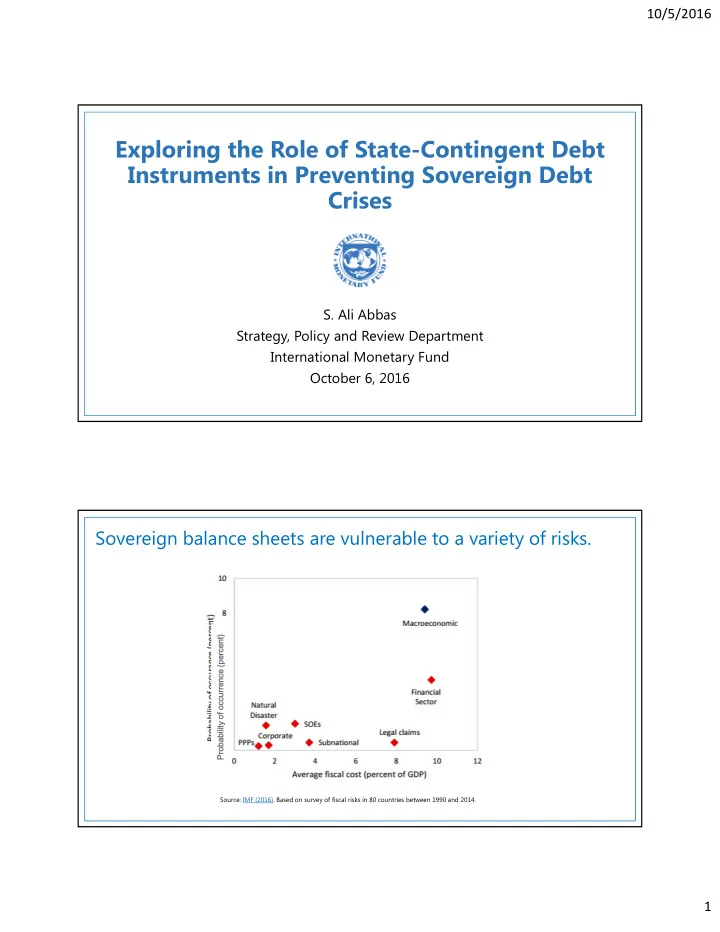

10/5/2016 Exploring the Role of State-Contingent Debt Instruments in Preventing Sovereign Debt Crises S. Ali Abbas Strategy, Policy and Review Department International Monetary Fund October 6, 2016 Sovereign balance sheets are vulnerable to a variety of risks. Probability of occurrence (percent) Source: IMF (2016). Based on survey of fiscal risks in 80 countries between 1990 and 2014. 1
10/5/2016 The sovereign toolkit to deal with these risks is… Tools to deal with risks to sovereign balance sheet Policy adjustment Risk sharing Self insurance Reserves, Private sector Official stabilization fund Official lending, swaps Nonmarketable Marketable Conventional debt Private Countercyclical State contingent instruments (and insurance official loans bonds; and related debt management Menu of state- hedging products strategies) contingent financial instruments (SCFIs) State-contingent financial instruments (SCFIs) - Instruments with contractual net payment obligations that are explicitly linked to a state variable/trigger event - And that seek to alleviate liquidity and/or solvency pressures during “bad” times SCFIs: Benefits and Complications Benefits Issuers Investors International financial system • Greater policy space in bad times Prospect of higher return in More complete markets • • • Esp. relevant for sovereigns: Increased risk-sharing between current low-yield environment • (i) with limited fiscal space; Potential diversification benefits public and private sectors, and • (ii) whose risk premia rise in vis-a-vis other assets, liabilities across countries (esp. in downturns; currency areas w/o fiscal union) in portfolio (iii) with constraints on monetary Lower risk of outright debt Efficient and timely prevention • • policy and resolution of debt crises default and related deadweight • Avoid problems associated with losses Better pricing of sovereign risk • rainy day funds Higher risk on private balance sheets may not be optimal in some circumstances (e.g. in GFC-type event) • Refinancing risk from pro-cyclical pricing: higher demand for SCFIs in good times (when payout is high) • Complications than in bad times Political costs: premia upfront, benefits kick-in only with scale • Pricing impact on conventional debt instruments (fragmentation of existing liquid instruments, • subordination concerns) 2
10/5/2016 Focus on state-contingent debt instruments Benefits relative to non-debt SCFIs • Derivatives and insurance products entail counterparty risk for the sovereign • Hedging typically only available at short tenors • SCDIs offer better tie-in to debt management strategy (longer horizon) How to design: • State/trigger variable: GDP , commodity price, hurricane? • Adjustment mechanism: automatic, continuous, symmetric, bounded? • Payment structure: indexation of principal and/or coupon; maturity extension? • Other: Currency, maturity, legal structure Conditions under which market for SCDIs could emerge Diversification benefits for both sides • Oil-price linked bonds issued by oil exporter to investor carrying mostly oil-importer risk Differential expectations on “state”/”trigger” variable • e.g., helped kick-start market for inflation-linked bonds • Differential growth outlooks could matter for GDP-linked bonds Other risk/preference complementarities • e.g., upside instruments in restructurings (issuer need for liquidity, investor more focused on overall return) • Investors’ desire for long-term GDP return matches issuer desire to stabilize debt/GDP • Sovereign cocos may avoid liquidity-induced credit event (damaging for both sides) 3
10/5/2016 Obstacles to overcome: • Novelty/liquidity premia: Market-makers, index eligibility, large volume issuance… • Pricing difficulties/data integrity: Simple design that is incentive-compatible • First-issuer reticence: Coordinated issuance? • Regulatory treatment: Rating, risk-weights; treatment in fiscal rules, DSAs • Seniority vis-à-vis conventional debt: Link to design, legal jurisdiction? 4
Recommend
More recommend